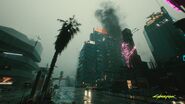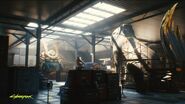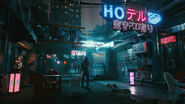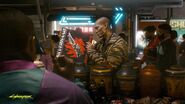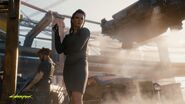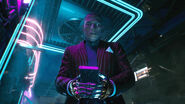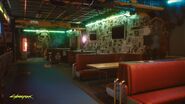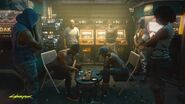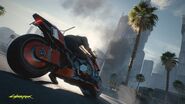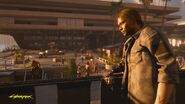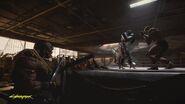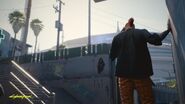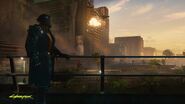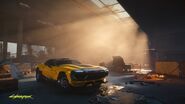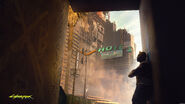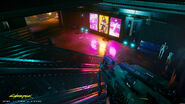Template:Gameicon1Template:Gameicon1Template:Gameicon1Template:Gameicon1Template:Gameicon1Template:Gameicon1
Template:Quote Night City is a city in the Free State of Northern California. It is located on the west coast of the United States. As of the year 2020 it is said to have around five million inhabitants across its many boroughs, and was by 2077 voted the "Worst place to live in America". It is the central location in the pen and paper RPG series Cyberpunk 2013, 2020, V 3.0 and Red and the upcoming Cyberpunk 2077 video game.
A planned urban community originally founded by Richard Night in 1994. It was established at the head of Del Coranado Bay, and facing the Pacific Ocean to the west, Night City is considered a modern multicultural and thriving metropolis of the 21st-Century overrun by corporations, corruption, organized crime and gang violence. It has wide streets and dense urban skyscrapers which are homes to over millions of people. It operates as a fully independent city-state with the Arasaka Corporation having complete control.
Night City is considered a thrilling and exciting location to visit, as well as an interesting and vibrant place to live for those of means, and a hellscape to the city's disenfranchised; its world famous slogan is "The City on the Edge of Tomorrow". Technology triumphant over the troubles of the past United States of America, a combination of cultures of the Old World, and a new beginning of the U.S.; Night City is now.
History
Richard Night
Night City was the brainchild of businessman Richard Night, who became dissatisfied with his experiences in managing corporate construction projects as part of his company Halsey, Ferris and Night. This led him to break off and form his own company Night International, with the end goal of creating the ideal city.
Situated in the Del Coronado bay, the city was originally going to be known as Coronado City and Richard Night envisioned it as a utopia, in which cities across the country could look up to as the gold standard. After the collapse many of the megacorps also looked at creating such a space, in which crime and poverty were non-existent, as well as the laws that impeded their sometimes unethical work. By 1992 megacorps Arasaka, EBM, and Petrochem had all invested heavily in Coronado City. Night purchased many of the rights as well as large swaths of land surrounding the Del Coronado bay from Petrochem to secure the land for the new city.
By 1993 the construction for the city was well under way, and the bay had been dredged and the upper peninsula had been extended. The existing residents of Del Coronado had been relocated to a new area known as Old Downtown and the central hub of the city, where the corporations were based would be the new downtown area.
Night Falls
After the construction for Coronado City was already under it's way, Night international employed a large number of innovative building styles and techniques. This resulted in the exclusion of many “old-boy” companies, including that of Halsey, Ferris and Skiv. During the first four years of construction, there were daily threats against Night‘s life. Night being a very confident and proud businessman, dismissed the threats as easily as they came. When the threats escalated to the level of sabotage and intimidation, he made a few calls to his Corporate allies, who had experience in dealing with such things.
However, despite his influence and his allies promising to deal with it, Night‘s luck finally ran out. On September 20th, 1998, Night was found dead in his penthouse suite at the top of the newly constructed Parkview Tower. Detectives found his body with a bullet wound, he was killed instantly. Night‘s killer never was found. To honor his memory, the newly appointed City Council officially renamed Coronado City to Night City.
The next seven years were chaotic as the powers that were battled for power over the city. The corporations controlled the civic government and the Corporate Center; the Mob controlled almost all service-related businesses. The City Police, forced to kowtow to both Mob and Corporate interests, became totally ineffective. During this time, the gangs, backed by Mob and Corporate sponsors, established themselves in the remaining suburbs of the old city; the one area that had never had the chance to be added to Night’s urban plan. The result became the infamous Combat Zone of modern day, with gangs so firmly rooted that the only way to remove them now would be to demolish the entire area.
The Mob Rule
By 2005, the Mob had become the king of the hill. The corporations established their strongholds in the outlying “Beavervilles” and their lofty Corporate Plaza fortresses. They had little or no interest in running the City, and the civic leaders were unable to lead without corporate masters to pull the strings and provide the muscle.
The next four years were the ”dark ages” of Night City, with more murders in that four year span than there were for most cities in ten. The Mob ruled the city with an iron fist, killing anything in its way. Gang activity was at an all time high- during this time,such notorious gangs as the Blood Razors and the Slaughterhouse made their debut. Night City soon became the closest thing to hell on earth; a war zone where you were just as likely to have your car blown up as have its radio stolen. The number of unsolved murders documented by the police rose into the thousands.
The Mob Wars and Corporate Takeover
The period between 2009 and 2011 was known as the mob wars. Night City had grown to be incredibly violent, with murder and gang activity at an all time high. It is unclear whether the corporations attempted to deal with the mob, but it is known that the Mob was bad business for the megacorps. The conflict came to an end when heavily armored Arasaka paramilitaries took to the streets in a show of force, overwhelming the Mob forces and leaving them effectively defeated.
The Corporations installed puppets in the local government and began the process of cleaning up the war-torn city. Night City's homeless problem grew out of control when new laws stated that anyone without the finances to renovate their home would be removed. Almost all of the city's affordable housing was occupied by the corps troops, resulting in the displacement of hundreds of residents. By the year 2020 the mob wars were a distant memory and Night City had become a relativity peaceful place, with the downtown area being policed at all times. However many dangers still remain, and the scars of previous conflicts have not yet healed. Weapons are commonplace in everyone's day to day lives and it would not be out of the ordinary to see a gun next to a briefcase on the sidewalk.
The newly elected Council, faced with chaos in the City, deputized Corporate security forces and allowed them full authority within the City limits. The Corporate and City Centers were cleaned out and restored to their pristine state. The old Harbor Mall (originally built in the 1980’s),was demolished and the New Harbor Mall constructed.
2013
By 2013, much of the worst excesses of the City had been crushed under the ruthless heel of the Megacorps. The basic services such as police, fire and support services had been reestablished, and if the Corporate masters were oppressive, at least to the average punk on the Street, it was better than dodging gunfire on the way to the Vendit booth.
2020
By 2020, Night City was a rapidly growing urban region, still rife with urban violence and street crime, but with strong economic growth in the Corporate sector. It was the quintessential city of the future—gritty, dangerous, but possessed of an urban slick and stylish cool that made it unique. As Bes Isis, Net 54 newscaster and one of Night City’s most well–known public figures put it at the time.
Because of its Free State status, Night City was home to units on both sides of the 4th Corporate War. Perhaps as a result, the War was not kind to Night City. There was constant street to street, building to building fighting throughout the City, especially around the Corporate Zone where both factions maintained substantial office complexes. Even before the nuclear event that wiped the center area out, people were abandoning the city in droves, doing what-ever they could do to avoid getting sniped by drones, crushed by tanks, or just gunned down by Corporate kill squads. A big chunk of the City was wrecked and people were climbing all over themselves to get to safer spots like Heywood and Pacifica. Then both sides went over the line and some bright boy set off a bomb
4th Corporate War: 2022
In retrospect, it was just Night City’s bad luck that it was a Free City in an area not controlled by a larger national power. Neither of the Corporate combatants was stupid enough to drop a nuke in the middle of some place where the remnant U.S. or the still powerful Eurotheatre held the reins. In fact, probably the only thing that kept then–President Kress from wiping out every Arasaka stronghold on Earth was the fact that Night City wasn’t technically part of the U.S. Then the nuke was dropped...
The twin Arasaka Towers were 140 floors tall, making them among the tallest buildings existent at the time. They were joined by a high bridge around the 60th floor mark. With the exact location of the Arasaka master database unknown, Militech decided the best course of action was to use a pocket nuke (carried by a hand–picked black ops team) to level the entire structure. The Militech team didn’t really care about the loss of life, as they had already written the City off as a loss to Arasaka months earlier in the War.
The bomb triggered in the Arasaka Towers was roughly twenty–five percent as powerful as the bomb at Hiroshima. A tactical nuke a bit larger than a “suitcase bomb.” It was designed to utterly demolish the master database and make it unusable in any way to a rival Megacorp. The Nuke was prematurely detonated at floor 120 (1200 feet), in Kei’s apartments where the Soulkiller lab was located.
The blast pretty much obliterated the twin towers, splitting them in half and causing them to collapse outward. The entire center of the city became rubble in seconds.Most people in the area died instantly. A lot of Night City was built on fill, because the original elevation was only sixteen feet above sea level. So, the Arasaka nuke caused a minor earthquake that liquefied parts of the fill and flooded the inner city.
The explosion was technically an air blast since the detonation went off at roughly 1,200 feet. (Little Boy, by comparison,had a detonation height of about 1,900 feet). While this lessened overall long–term radioactivity, most of what remained penetrated only the huge skyscraper towers surrounding the blast (they were later scraped off and buried as fill in the Bay). The high blast area and the tons of raw concrete and steel there was instantly converted into particulate debris which rained down on the entire NorCal region and far out to sea for many months.
The dust cloud spiraled up into the sky, turning it red for almost two years. Even several years after the blast, suspended particles caused the skies at dawn and dusk to glow a lurid crimson, inspiring people who lived through that time to call it the Time of the Red.
After the Fall: 2023 - 2025
Night City was inhabitable within 24 hours of the detonation. Many people were unaffected as they were heavily cybered up or had radiation filters installed in their bodies already. However, the Nuke and its aftermath destroyed a large part of Night City’s housing, forcing people to move out to the suburbs or to areas even further out from the city’ center. Worse, the liquefaction of the fill the city was built on broke gas mains, water pipes, and electrical grids. Streets became twisted chunks of asphalt, strewn with wrecked ground cars,while fallen AVs lay scattered among the debris of broken skyscrapers. Night City might technically be inhabitable but it was far from pleasant. Even then, it wasn’t as bad as some other cities like Rio and Hong Kong.
Much of the area beyond Greater Night City had been abandoned during the Collapse. But now, people started moving north, south, and east as soon as they could.Neighborhoods found a new unity and purpose, even if it was grudgingly built on a shaky foundation. They weren’t looking for rebuild yet. They were looking for food,clean water, and shelter. In a wasteland of ruins, gangs, renegade Corporate fighters, and radioactive wreckage, the denizens of Night City were in survival mode. And survival is what the inhabitants of Night City do best.
2030s
President Kress blamed the Night City attack on Arasaka, although she was soon able to determine that the actual weapon used had been supplied by a Militech strike team. The Big Lie was that Arasaka blew up the Corporate Center in an area denial attack to stop Militech from seizing the Arasaka’s Night City office. In point of fact, Arasaka did actually have a much larger thermonuclear device buried in the foundations of the Towers for just that reason, but the explosion of the Militech pocket nuke rendered this plan inoperable. No one knows where the Arasaka Bomb actually wound up after the Fall of the Towers, and since only a few of the upper echelon of the zaibatsu (such as Kei and his father Saburo) even knew about this fallback, the knowledge of the Arasaka weapon has since passed into the realm of legend.
Very few people knew anything about the Militech–backed strike team or its composition. Rumor has it that the veteran Solo, Morgan Blackhand, operating as a hidden government asset, passed the information about the failed raid onto President Elizabeth Kress independently; this is still only in the realm of legend, as no one has seen Morgan Blackhand or his corpse since the Fall of the Towers. In any case, Kress used this (and the reactivation of General Lundee’s commission) to gain leverage over Militech, bringing it to heel and nationalizing its assets as part of a resurgent US Government. Bringing the full force of her military and propaganda resources to bear, Kress painted a lurid picture of Arasaka as an evil foreign Megacorp run by a madman, who wantonly destroyed an American city in the pursuit of personal power. Arasaka’s charters to operate in the United States were immediately revoked, its members and board declared terrorists, and its assets either seized or driven off-shore.
Yet, for all of this political theater, Kress showed little or no interest in helping Night City recover. Much as previous Presidents during the Collapse had done, she wrote the city off as unrecoverable and offered sanctuary in a new United States to the surviving refugees. There were two reasons for this; first, with the resources of the United States already stretched to the breaking point,there really were very few options left to Kress. Second, the flinty and farsighted American President saw this as the perfect way to bring the wayward “Free State of NorCal” (and its lucrative technology base) back into the Government’s control. But stubborn to the end, Night City fought back.
2040s
Roughly two million people in the greater Night City region were left homeless due to the Bomb, either directly or because of flooding from the liquefaction of the city’s foundations. Survivors fled into overcrowded tent cities in the surrounding suburbs of North Oak, Westbrook, Pacifica, Heywood, and South Night City. But tent cities aren’t real homes and it was obvious that something needed to be done fast.
The remnants of the Night City government turned to outside resources, calling in old markers and favors from a wide variety of Edgerunners. Recovery was lead by the Nomads of the Aldecaldo Clan and their allies in the StormTech Corporation. With a lot of experience in city rebuilding due to the Chicago project, StormTech and the Aldecaldos were uniquely equipped to construct extensive temporary housing from shipping containers and later formocrete modules brought in by rail and sea.
But first, the ground needed to be cleared to put up even these rudimentary structures. Most of central Corp Zone had been destroyed. The wreckage was far too vast to dig up and cart to distant landfills, so the survivors used bulldozers and jury–rigged main battle tanks (abandoned by both sides) to shove the debris into the Bay. Most of Night City’s in neighborhoods had already been razed to the ground in the ceaseless battles preceding the Fall of the Towers. Now, the wreckage became the land that new mega–buildings and old cityscapes rose upon, once more ready to challenge the smog filled skies. And the building keeps going on, despite gangs, plagues, riots, and all the other inconveniences that are just another part of the Time of the Red.
This ongoing rebuilding period has also cemented Night City’s relationship to the outer world. Abandoned by President Kress and her “New” United States, Night City has no intention of ever yoking itself to that tottering governmental shibboleth again. Kress’s successors are going to be in for a really long and ugly war if they want to take this particular Free Zone back into the fold; fract, they might even ask Arasaka for help if it comes to that. As for the European Theater; the Euros can go their own way just as long as they don’t mess with Night City’s particular path. Like a cyberfighter who’s been hit, knocked down, and has risen again with a scream of heavy metal rage, Night City has dreams. It dreams of becoming the biggest, baddest, most important city on the planet one day. With all that happened during the War, Night City realigned with Arasaka, rather than Militech and the "New" United States.
2070s
By 2070, Night City had emerged from a war between the New United States and several secessionist states as a fully independent city-state with Arasaka firmly in control.[1]
Government
New City Democratic Mayorality, with corporate-controlled city council. Popular votes are cast via a dataterm, using IdentiCard registration software. The city council consist of a house of representatives chosen by the top ten largest Corporations present in Night City. The place operates As a City State, a sovereign nation separated from the rest of the U.S., it's borders are patrolled by the Arasaka police.
Mayors of Night City
Business sectors
The business sectors of Night City include manufacturing industries, international trade and commerce, information services, electronic technologies, security services, and so on. While cities like Tokyo, New York, or Singapore have been overrun by corporations by the 2000s, Night City is the only city in the world that was built by the Corporations. Some of the biggest Megacorporations in the world contributed to the construction of the city and many are located in the Corporate Center.
MegaCorporations of Night City:
The following were some of the leading Corporations that helped construct the city, but it's just a few of the ones that still operate in Night City. The city is overrun by many corporations and businesses, some of which are exclusive to Night City. Without the official aid of U.S. government or the free state, Night City is a free nation that sees little interference from the outside. Night City's biggest ally is Arasaka, which keeps the city running and protected.[2]
Location
Night City metropolitian area.
Night City is located on the west-coast of the United States in the Del Coronado Bay, as negotiated in the Northern Separation Treaty of 2012, Night City is considered to be part of the Free State of Northern California; that being said, access is guaranteed to travelers from the Free State of Allied Southern California. Nearby city travel ranges from 4 to 6 hours to San Francisco and Los Angeles, depending on road gang conditions and road quality.[3]. Night City is surrounded by the Badlands region.
Weather
Night City's Northern Californian location gives it one of the most pleasant climates in the Western part of the US. Normal temperatures range from the mid 80°F to low 50°F (26°C to 10°C), with misty white fog blanketing the City in the early mornings and evenings. Night City receives around 21 inches of rainfall each year. Of this water that drops, around 35% contains toxic chemicals which is higher than the current government standards for the United States produced vehicles, clothing, and food. On average, if a person's vehicle and clothing are rated above SP 12, adverse effects (staining and ablation) will be negligible.
When one visits Night City, they should wear light to medium weight clothing, with a light armor jacket or ballistic-cloth overcoat which is optional. A filter mask and supplemental oxygen are highly recommended as well, this is a hedge against inversion smogs and acid rain fog. That being said, acid-proof slickers, umbrellas, and air masks are readily available from the sidewalk vendors or smaller street stores during a smog warning periods. The average cost of these items can range from 20 to 35 Eb.
Transportation
Night City hosts a extensive network of urban freeways and metro rail networks. Getting from the city's various districts is seamless and effective except for in districts where the infrastructure has been damaged such as in Pacifica. Interstate 828, 928 and 16 are freeways in 2020 altough it is uncertain whether these have since been renamed, rebuilt or remain unchanged in 2077. Also, the Orbital Air Space Center is a aerospace center in Night City, allowing for space transportation.
Zones of Night City 2020
The Night City metropolis is built up on dozens of small zones, and is surrounded by larger suburban zones. Zones A through C make up the downtown area, Zone D is the violent crime-ridden hell hole known as the Combat Zone, and Zones E through J are the wider suburban area.
| Location | Zone | Sectors |
|---|---|---|
| Downtown | Zone A | Little Italy, Northside District, City Center, Upper Eastside, Upper Marina, East Marina |
| Downtown | Zone B | West Hill, Corporate Center, Bank Block, Medical Center, Old Downtown, New Harbor |
| Downtown | Zone C | Night University, Lake Park, Eastpark and Japantown, Little China, Studio City, Charter Hill |
| Combat Zone | Zone D | Combat Zone |
| Suburb | Zone E - South NC | Night City Municipal Sewage Plant, San Morro Bay Cargo and Container Port, Petrochem Refinery Terminal |
| Suburb | Zone F - Westbrook | Executive Estates |
| Suburb | Zone G - Pacifica | WestWind Estates, Coastview, Playland By the Sea, Pacifica Arcology |
| Suburb | Zone H - NorthOak | The Oaks, NORPAC Naval HQ, NORCAL Airforce HQ, NORCAL Army HQ |
| Suburb | Zone I - Rancho Coronado | Arasaka Weapon Assembly Facility A-45, Biotechnica Mono-clonal Research Station, EBM Remote Assembly Facility, Militech Armored Assault Group Training & Live Fire Range |
Zones of Night City 2077
Cyberpunk 2077 shares some districts in common with the traditional layout of Night City, with some exceptions. Each district will have a dominant gang.[4] The city is divided into six districts, each with their own environment and denizens. There are 16 sub-districts and the total size of the city is 75.42 km².
| District | Areas | Info |
|---|---|---|
| City Center | Downtown, Corpo Plaza | That's City Center – Night City’s corporate showcase. Sleek skyscrapers form a brutalist, fortress-like skyline, presenting the unrivaled power of megacorps in all its arrogance. Since 2020, the City Center has become the most fortified and secure part of Night City. |
| Watson | Little China, Kabuki, Northside Industrial District, Arasaka Waterfront | Watson used to have it all. Nightclubs, skyscrapers, corporate offices, a top-end medcenter — but economic disaster put an end to all that. Now, it’s known as ‘the bad neighborhood of Night City’. The kinda place that suits gangs like Maelstrom and Tyger Claws down to the ground. |
| Westbrook | Japantown, North Oaks, Charter Hill | Westbrook is considered by many to be the best place to live and have fun in Night City. If you’ve got eddies, you come here to spend them. And if you don't? Well, take out a loan and pretend you’re on top of the world — even for just one glorious night. |
| Heywood | Well Springs, Vista Del Ray, The Glen | Heywood is a neighborhood of contrast—from modern skyscrapers and parks in the north, to dangerous, inhospitable slums in the south. It's “the biggest bedroom in Night City”, where gangs like Valentinos and 6th Street get down to business—legal and illegal alike. |
| Pacifica | West End Estate, Coast View | Pacifica could've been Night City’s money-making vacation resort, but once the investment dried up it became a husk left to rot. Now, instead of tourists, the district is overrun by gangs and violence, with The Voodoo Boys protecting the community forsaken by NCPD. |
| Santo Domingo | Arrayo, Rancho Coronado | Santo Domingo is one of Night City’s oldest districts. Corporations use it as a testing ground for industrial projects, destroying old factories just to build new ones, while residents scrape a desperate living in crowded megabuildings — wishing for something better. |
| Badlands | Sparsely populated by Nomads, the Badlands are the vast plains outside of the city proper. Unchecked resource extraction, burning oil fields, rampant pollution; this district makes Night City feel like a rich oasis. But it holds golden opportunities for those in the know. |
Gallery
Trivia
- According to Mike Pondsmith: "Night City was created on the "bones" of Morro Bay, a town I often drove through on my various road trips. I liked the place and in one of those flights of fancy young designers have, I wondered what it would take to buy the whole thing. The basic structure is still there in the Night City map, if one allows for an impressive amount of fill required to build out the upper area around the "Rock." (this is not unthinkable--a large amount of downtown Seattle and San Francisco were both built on fill ). I actually have a map that shows how the whole thing goes together geologically; one day I'll have to post it."[5]
- The street grid of Cyberpunk 2020's Night City draws some resemblance from the downtown street grid of San Francisco.
References
- ↑ Game Informer Issue 327, June 30 2020
- ↑ FISK, C. Night City Sourcebook. 1st ed. Berkeley CA: R.Talsorian Games, 1991
- ↑ Cyberpunk Red Worldbook p.21: "Freeways: Night City is on State Highway 828, which runs east to connect to I–5. Ground transit to San Francisco is about four hours due to road gang activity and bad roads; to LA about six hours."
- ↑ Cyberpunk 2077: Deep Dive
- ↑ Confusing Lore issue, location of Night City - Mike Pondsmith
Cyberpunk Red Jumpstart Kit World Book. Talsorian Games, 2019
FISK, C. Night City Sourcebook. 1st ed. Berkeley CA: R.Talsorian Games, 1991


